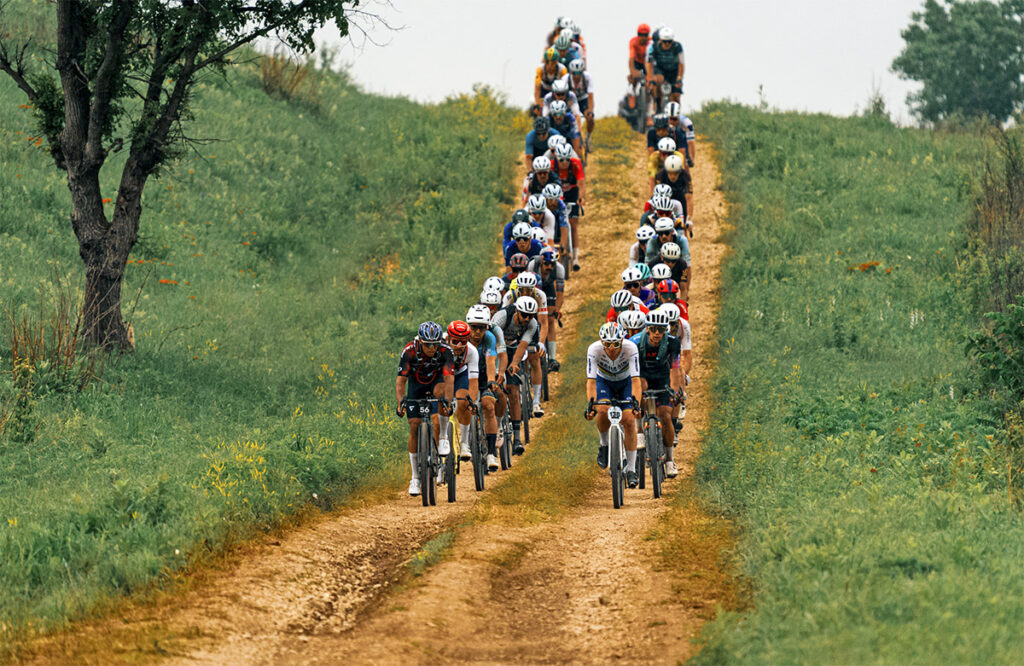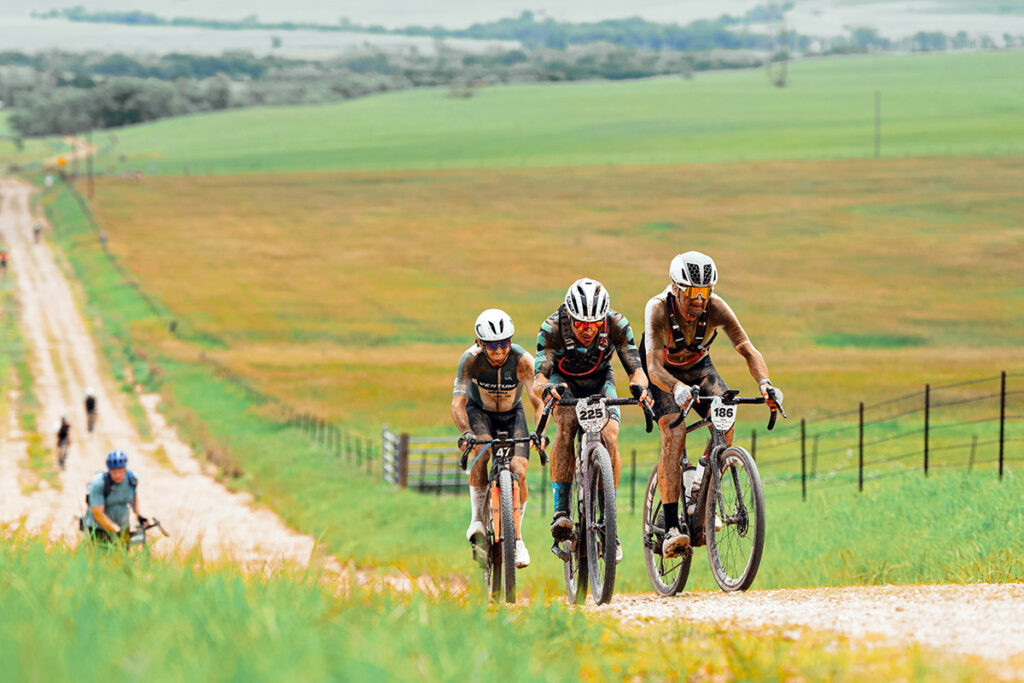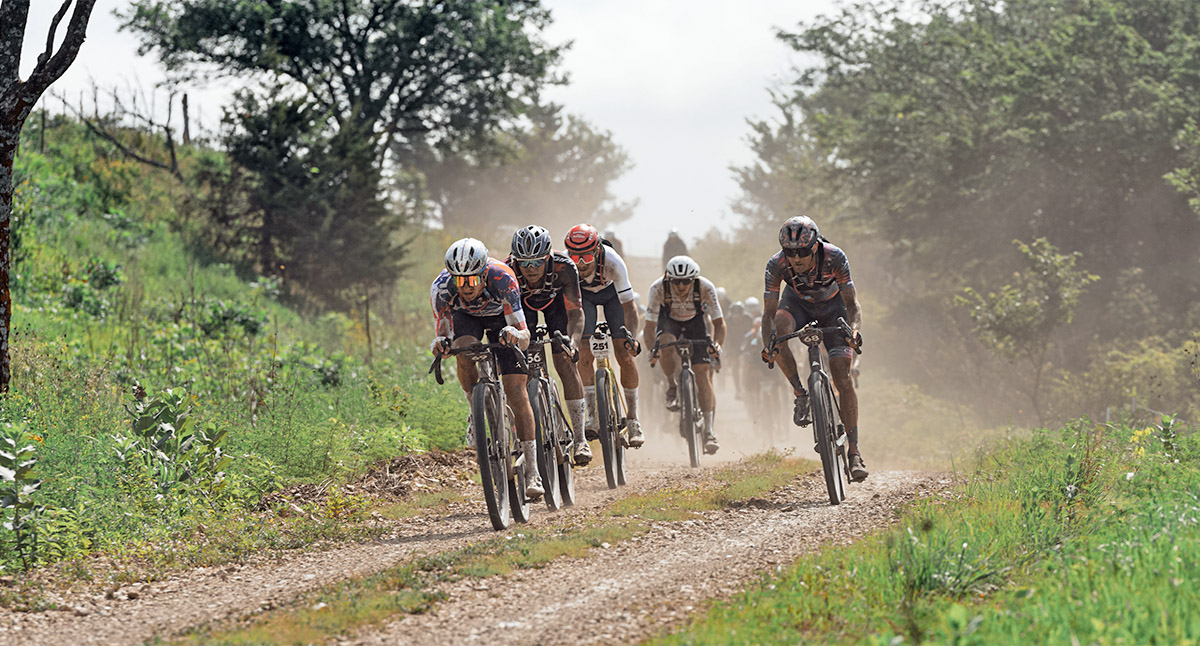8 Take-Aways from Unbound 2024
Unbound, the gravel race across the Flint Hills of Kansas, keeps getting bigger with every year—in every way. This year, more than 5,000 riders lined up in various categories to test their stamina, skill and speed. I don’t know whether Unbound is the world’s biggest gravel race, but it certainly has become the most important one.
Unbound now attracts the world’s best racers: This year’s roster read like a Who’s Who of professional cycling, not just in the 200-mile race, but also in the 100-miler and the 350-mile XL. The expo area had tents from most major brands. Journalists from all over the world converged on Emporia to interview pro racers and document new gear and bike setups. Unbound is a big deal these days!
If you want to know where gravel is today and where it is headed, Unbound is the place to find out. Here are eight take-aways from this year’s event:
Winning Unbound depends on luck
None of the favorites made it onto the podium this year. That’s not entirely a surprise: The field is now so deep that there are at least 20 or 30 potential winners. Who comes out on top from that group depends on who makes it into the right breaks and doesn’t suffer from mechanicals. Or as Ted King put it: “What we see is a balance of performance and survival. A course like Unbound is so long and so rough, but also so hard-fought among all the fastest gravel pros out there, that the fastest ride is the cleanest ride. The most aero bike or strongest legs won’t necessarily win you the race, but an error or mechanical will quickly end your race at the front.”

Gravel is getting faster and more professional
New records were set in most races. I remember when we discussed whether it was possible to ride 200 hilly miles across the Flint Hills in less than 10 hours. (That threshold was crossed in 2019.) This year, Lachlan Morton won the race in just 9:11 hours, averaging 22 mph (35.4 km/h) on a course that can only be described as challenging. And in the XL, the winners almost broke the 20-hour mark for the 355 miles (571 km), at an average speed of 17.5 mph (28.1 km/h)—despite spending 40 minutes navigating the 2-mile mudpit that was an XL-exclusive this year.
To put this evolution in perspective: The last time Unbound XL ran on the northern course—in 2021—my time this year (27:23 hours) would have put me in 13th place. This year, I finished 41st. That is a good thing: You don’t go to Unbound unless you want to test yourself against the world’s best riders.
With speeds like this, it makes sense to start the professional peloton in the 200-mile race separately from the ‘rest of the pack.’ While it was nice in the past to line up next to pros like Lachlan Morton and Ted King, the reality was that the pros rode off the front almost immediately. The only amateurs who stayed with them were riding beyond their abilities, making the race dangerous for everybody, before they inevitably dropped back.

The Spirit of Gravel is alive and well
The ‘Spirit of Gravel’ does not depend on riding next pros for a mile or two, but on what happens as the race settles in. I can only talk about the XL… There was a real sense of camaraderie, of working together to achieve the common goal of finishing, rather than racing each other. There was a sense of shared adventure. That was the real Unbound.
The spirit of gravel is alive and well among the pros, too. These riders race because they love cycling. They’re just really good at it. And the nicest riders seem to be best at it. I think that’s because gravel racing requires a variety of skills—both mental and physical—that go far beyond just raw power. Thus it was encouraging to see Inno Zavyalov (above) in the lead as the race left the first checkpoint. He’s one of the nicest and most interesting guys you’ll find on any ride.

And the eventual winner, Lachlan Morton, can only be described as the ‘fan favorite.’ Ted King had this to say about Lachlan: “He’s fun, he’s competitive, he’s friendly, and always races with classy panache. He’s raised hundreds of thousands of dollars for a long list of charities through his wild rides. He works to help develop cycling in the developing world. His list of palmarès and FKTs comprises one of the most eclectic mix of events two wheels have ever seen.”

And then you have women like Laura King (Ted’s wife), who balances family life, work and racing—and rode to an incredible third place in the 100-mile race, averaging close to 19.5 mph (31.4 km/h).
That doesn’t mean that these riders aren’t serious about racing. They train hard, and they fine-tune their equipment to the nth degree. The ever-increasing speeds are a result of this process. Here are a few trends we noticed at Unbound this year:

Tires are getting wider
The days when racers tackled the Flint Hills on 35 or 38 mm tires are long gone. Inno Zavyalov (above) ran a 44 mm Manastash Ridge on the front and a 48 mm Hatcher Pass on the back. He explained: “Typically, in my experience, most flats happen on the rear tire. You can pick up the front wheel and move it out of the way of a sharp rock, but at the back, you just hit stuff with less finesse. Also, if there is a small aero penalty for a wider tire, that applies less in the rear.”
Winner Lachlan Morton went the other way, with a wide 2.1″ tire on the front and a 44 mm on the rear. In his case, the narrower rear tire apparently was a result of the limited clearance of his frame. Despite his wide tires, Lachlan ran rims that were just 21 mm wide (internal)—obviously without any trouble. Bucking the trend toward one-by drivetrains, Lachlan ran a double—perhaps because he’s sponsored by Shimano, which doesn’t (yet?) offer an electronic one-by for gravel.

Aero is everything
At average speeds of 22 mph, wind resistance is the main factor determining a rider’s speed. (Tires are second.) Wind resistance is determined mostly by the aerodynamics of the rider: Teardrop-shaped stem spacers and wing-shaped handlebars may show (small) gains in the wind tunnel and in CFM computer simulations, but on the road, rider position matters far more. Aerobars are no longer permitted in the pro peloton, but racers run narrow handlebars and tilt their brake levers inward to get the most aero body position possible without giving up control or comfort on the rough roads. (Above are Chase Wark and Inno Zavyalev during their long break.)
With few rules governing the bikes in gravel racing—in theory, you could race a recumbent for the ultimate in aero performance—it’s likely that gravel bikes will evolve further to become more aero. Gravel handlebars already have a pronounced flare, so riders can get leverage in the drops, but enjoy a narrow aero position on the hoods. Aero wheels don’t work well with wide tires—the rims would have to be too deep to obtain good air flow—but there are other places where the aerodynamics of bike and rider could be improved. The shorty fenders of my bike that shield the tire tops (as on Moto GP bikes) have shown similar aero gains in the wind tunnel as aero wheels (with matching-width tires). There’s still room for development in the aerodynamics of gravel bikes…

Flint Hill rocks are just rocks
Much has been made of the brutally sharp rocks of the Flint Hills. In my experience, they aren’t sharper or rougher than those we encounter in the Cascade Mountains. What’s different is that the pro racers hammer across them with huge power outputs and often without being able to choose the best line. That stresses any tire to the limit and beyond.

For the rest of us, Kansas gravel is just that: gravel. I ran Extralight tires in the XL without any tire problems. In fact, after a quick wash, my tires look as good as new: 355 miles isn’t a lot for a 54 mm tire, and gravel tends to wear tires less than pavement. However, I was riding across rough sections like the infamous Little Egypt at 15 mph (24 km/h) rather than 22 mph (35 km/h), by myself, able to pick the best line. I rode that section at night, and it was a lot of fun.
Running ultra-wide tires (54 mm) at ultra-low pressure (22 psi/1.5 bar) greatly reduced the risk of flats. Such a soft tire is much harder to cut, as it tends to move out of the way of sharp rocks rather than push against them. I was running Rene Herse TPU tubes, which further reduces the risk of sidewall cuts compared to a tubeless setup. (Tubeless setups stretch the casing much tauter, which is why the same tire is wider when set up tubeless compared to tubes.) My bike’s low-trail geometry means that I’m not gripping the handlebars tightly, so the front wheel can deflect when it hits big rocks. That’s a pretty unique combination of factors, and it worked well—for me.
There’s always an element of luck, too. With any tire that has air in it, there’s a risk of sidewall cuts. Compared to the Endurance or Endurance Plus casing, the risk was higher with my Extralights. It was a calculated risk: If I had a flat, it would have cost me about 5 minutes. The benefits of the Extralight’s lower rolling resistance, greater comfort, and improved traction far outweighed that risk over the 355-mile XL—for me. For a pro racer, where any stop means getting dropped from the lead group, that calculation looks very different.
I have to admit that I chose to race on Extralights partially as an R&D experiment. We know how our sturdier casings perform in the Flint Hills, both from our racers and from my own experience in 2022. Running the Extralights added valuable data. It was the right choice for me in the end—but I don’t expect many racers to run Extralights in the future. For the pro peloton, I second Ted King’s recommendation of the Endurance Plus casing. For everybody else, the Endurance is an excellent choice.

Kansas Mud is worse than you can imagine
There’s the story that the Inuit have many different words for snow. I think Unbound racers will develop just as many words for different types of mud. Just like all snow is frozen water, but can it be dry and fluffy, or wet and sticky, Unbound mud is always a mixture of silt, clay and water. What makes it different is how deep the mud is and how much it has dried out. In 2022, everybody encountered what I’ll call ‘Squish’: Fresh, liquid mud that made it hard to keep the bike upright, but with momentum and skill, the pros were able to ride through it, while the rest of us got stuck. Last year (above) saw the ‘Peanut Butter’ that sticks to everything it touches, clogs up your frame, and makes no distinction between fast and slow riders.
Most courses this year were devoid of mud, but the long XL course wasn’t so lucky. Or perhaps we should be grateful for the adventure? We had some ‘Slippy’ mud that is like riding on ice. Not too bad… except, unlike ice, the mud isn’t smooth. So your bike gets deflected on bumps and suddenly veers off-course as you instinctively countersteer to stay upright. It’s exciting when that happens at speed on a two-track, and you’re suddenly riding through the deep grass next to the road.
We also had the worst-possible peanut butter mud. The surface was dry, tempting us to ride, but this was just a thin surface crust. What lurked underneath had dried just enough to be ultra-tacky. It was far more sticky than peanut butter. It locked up our wheels within a single revolution and stopped us in our tracks. The only way forward was portaging the bike, but the mud made it so heavy that we first had to scrape off 20 pounds or more. And every time we thought we’d cleared the mud pit, we rode only a few meters before breaking through the dry crust again…. Even the race leaders took 40 minutes to traverse this 2-mile section. (I spent 50 minutes.) I’m at a loss trying to find a word for this type of mud, but I’m sure that, as Unbound continues to see different types of mud, racers will develop a more complete vocabulary for mud.

Kansas is beautiful
Hilly grassland, deep ravines, towering cliffs… The Flint Hills are beautiful, and the riding there is just amazing. You’d think riding for 27 hours through Kansas would get boring, but I enjoyed the landscape for every mile of it. The course feels very remote, especially at night. The technical sections are challenging (and fun), but not relentless, and there’s plenty of smooth gravel to relax. The small towns are charming, with old stone buildings on Main Street and clapboard houses surrounding them. If the distances weren’t so vast, I’d say the Flint Hills are a perfect place for bike touring. It’s definitely a great place for a gravel race, and that’s one of the reasons Unbound is so popular. It’s really that special.
Further Reading:
Photo credits: Marc Arjol Rodriguez/Velophoto.tx (except 5, 9, 10); Life Time (Photo 10)



